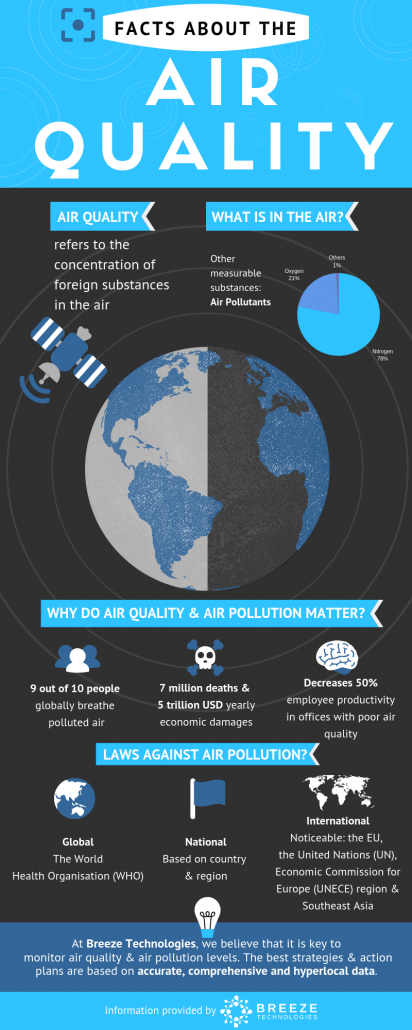What Is Air Quality? Why Does It Matter?
Find out more about the importance of air quality, current laws and regulations and how we can monitor and improve air quality to create a healthier and more liveable environment.

What is air quality?
Our air mainly consists of two gases: nitrogen (ca. 78%) & oxygen (ca. 21%). Besides those two, we breathe carbon dioxide, argon and traces of a number of other gases. If other substances are measurable in the air, those are called air pollution.
Air quality refers to the concentration of foreign substances in the air. Air quality indices and recommendations are defined based on scientific knowledge and insights on how the harmful pollutants impact humans and the environment. Thus, the discussion about the qualified air, legal standards and efforts to limit pollution vary based on many factors. These are due to different countries, the particular environments (e.g. general outdoors or workplace) and the duration of pollution exposure.
Why do air quality and air pollution matter?
Most of the air pollutants are harmful to human health in various ways, also negatively impact ecosystems and climate. More specifically, 9 out of 10 people globally breathe polluted air. Air pollution causes 7 million deaths per year and 5 trillion USD in yearly economic damages. Employee productivity, for example, can decrease by up to 50% in offices with poor air conditions. This explains why air pollution features prominently in the UN Sustainable Development Goals (SDGs).
More and more governments and NGOs recognize the risks of air pollution threatening our society. So they are setting up legal frameworks to protect citizens, local ecosystems and our planet.
Are there any laws and regulations against air pollution?
- Globally: The World Health Organization (WHO) sets recommended limits for health-harmful concentrations of key air pollutants both outdoors and inside buildings and homes, based on a global synthesis of scientific evidence. Its guidelines cover annual and daily concentrations of fine particulates, nitrogen dioxide, sulphur dioxide, carbon monoxide, ozone, and other pollutants.
- Internationally: There are a number of international environmental laws and regulations applying to pollution levels. These consist of agreements related to trans-national pollution rate, and greenhouse gas emissions. Transboundary air pollution is addressed through a patchwork of regional instruments, most notably in the EU (e.g. the “Air Quality Directive” 2008/50/EC), the United Nations (UN), the Economic Commission for Europe (UNECE) region and Southeast Asia.
- Nationally: Air quality standards vary based on country and region. Taking the United Kingdom as an example, the country has legislated independently, as well as implemented EU standards (e.g. the aforementioned 2008/50/EC) into its national laws. In June 2010, regulations introducing a new control framework for PM2.5 came into force, as required by the Air Quality Directive. They set a national exposure reduction target defined as a percentage reduction in annual average concentrations of PM2.5 in urban background locations across the country, to be achieved by 2020.
Taking up the fight against air pollution
Acknowledging air pollution as the greatest environmental health threat of our time, there are ways for individuals to take action and prevent air pollution. Above all, monitoring air quality and pollution levels is an essential part of clean air actions. At Breeze Technologies, we believe that the best clean air strategies and action plans are based on accurate, comprehensive and hyperlocal data.
Find out more information about our solutions to fight against air pollution to create a healthier and more liveable environment.
Link: Discover our air quality monitoring and intelligence solutions

 Ant Rozetsky / unsplash.com
Ant Rozetsky / unsplash.com European Commission
European Commission